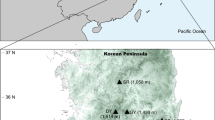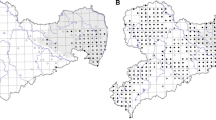Abstract
Population genetics studies are widely recognized for generating useful knowledge for biodiversity conservation. To date, however, little is known about the levels and distribution of genetic diversity of Drymis brasiliensis (Miers LC), a tree species from the Atlantic Rainforest. Therefore, in this study, we investigated how genetic diversity is distributed within and among populations of D. brasiliensis from southern Brazil using allozyme markers to genotype reproductive trees (8 populations) and seedlings (3 populations). Furthermore, in two populations, we established two permanent plots (5.1 and 1 ha) to analyze fine-scale genetic structure (FSGS). Studied populations presented low levels of genetic diversity (reproductive = 0.085; seedlings = 0.054) and high fixation indexes (reproductive = 0.396; seedlings = 0.231). Genetic divergence among populations was equal to 0.05, which is significant, signaling that few populations can conserve large portions of the species total genetic diversity. FSGS was only detected for one population, when reproductive individuals were separated by less than 40 m. Low genetic diversity combined with high fixation indexes clearly signal a risk of losing diversity. Therefore, conservation efforts should be aimed at enhancing gene flow within the studied populations.



Similar content being viewed by others
References
Alfenas AC (1998) Eletroforese de isoenzimas e proteínas afins: fundamentos e aplicações em plantas e microorganismos. Editora Universidade Federal de Viçosa, Viçosa, p 574
Antiqueira LMOR, Kageyama PY (2014) Genetic diversity of four populations of Qualea grandiflora Mart. in fragments of the Brazilian Cerrado. Genetica 142:11–21
Backes P, Irgang BE (2002) Árvores do sul: guia de identificação e interesse ecológico. Clube da Árvore, Instituto Souza Cruz, Santa Cruz do Sul, p 326
Bawa KS (1990) Plant-pollinator interactions in Tropical Rain Forests. Annu Rev Ecol Syst 21:399–422
CNCFlora (2012) Drimys brasiliensis. Lista Vermelha da flora brasileira versão 2012.2. http://cncflora.jbrj.gov.br/portal/pt-br/profile/Drimysbrasiliensis. Accessed 12 March 2018
de Lacerda AEB, Kanashiro M, Sebbenn AM (2008) Effects of reduced impact logging on genetic diversity and spatial genetic structure of a Hymenaea courbaril population in the Brazilian Amazon Forest. For Ecol Manage 255:1034–1043
del Hoyo A, López-Pujol J, Chung MY, Lasso de la Vega B (2012) Population genetics and conservation of the extremely narrow Pyrenean palaeoendemic Glandora oleifolia (Boraginaceae). Plant Ecol Divers 5:501–511
Diniz-Filho JAF, Melo DB, Oliveira G, Collevatti RG, Soares TN, Nabout JC, Lima JS, Dobrovolski R, Chaves LJ, Naves RV, Loyola RD, Telles MPC (2012) Planning for optimal conservation of geographical genetic variability within species. Conserv Genet 13:1085–1093
Diniz-Filho JAF, Diniz JVBPL, Telles MPC (2016) Exhaustive search for conservation networks of populations representing genetic diversity. Genet Mol Res 15:1–10
Ellegren H, Galtier N (2016) Determinants of genetic diversity. Nat Rev Genet 17:422–433
Fægri K, van der Pijl L (1979) The principles of pollination ecology. Pergamon Press, Oxford, p 224
Frankham R (2003) Genetics and conservation biology. C R Biol 326:22–29
Frankham R, Bradshaw CJA, Brook BW (2014) Genetics in conservation management: revised recommendations for the 50/500 rules, Red List criteria and population viability analyses. Biol Conserv 170:56–63
Gottsberger G, Silberbauer-Gottsberger I, Ehrendorfer F (1980) Reproductive biology in the primitive relic Angiosperm Drimys brasiliensis (Winteraceae). Plant Syst Evol 135:11–39
Goudet J (2002) FSTAT, a program to estimate and test gene diversities and fixation indices (version 2.9.3.2). http://www2.unil.ch/popgen/softwares/fstat.htm. Accessed 6 May 2016
Hamrick JL, Godt MJW (1989) Allozyme diversity in plant species. In: Soltis D, Soltis P (eds) Isozymes in plant biology. Dioscorides Press, Portland, pp 43–63
Hardy OJ, Vekemans X (2002) SPAGeDi: a versatile computer program to analyse spatial. Mol Ecol Notes 2:618–620
Hedrick PW (2001) Conservation genetics: where are we now? Trends Ecol Evol 16:629–636
Hmeljevski KV, Reis A, Montagna T, Reis MS (2011) Genetic diversity, genetic drift and mixed mating system in small subpopulations of Dyckia ibiramensis, a rare endemic bromeliad from Southern Brazil. Conserv Genet 12:761–769
Li CC (1976) Population genetics. University Chicago Press, Chicago, p 366
Loiselle BA, Sork VL, Nason J, Graham C (1995) Spatial genetic structure of a tropical understory shrub, Psychotria officinalis (Rubiaceae). Am J Bot 82:1420–1425
López-Sepúlveda P, Takayama K, Greimler J, Crawford DJ, Peñailillo P, Baeza M, Ruiz E, Kohl G, Tremetsberger K, Gatica A, Letelier L, Novoa P, Novak J, Stuessy TF (2014) Progressive migration and anagenesis in Drimys confertifolia of the Juan Fernández Archipelago, Chile. J Plant Res 128:73–90
Lowe AJ, Boshier D, Ward M, Bacles CFE, Navarro C (2005) Genetic resource impacts of habitat loss and degradation; reconciling empirical evidence and predicted theory for neotropical trees. Heredity 95:255–273
Mantel N (1967) The detection of disease clustering and a generalized regression approach. Cancer Res 27:209–220
Mantovani A, Morellato LPC, Reis MS (2006) Internal genetic structure and outcrossing rate in a natural population of Araucaria angustifolia (Bert.) O. Kuntze. J Hered 97:466–472
Mariot A, Mantovani A, Bittencourt R, Ferreira DK, Reis MS (2010) Estrutura populacional e incremento corrente anual de casca-de-anta (Drimys brasiliensis Miers—Winteraceae) em Caçador, Santa Catarina, Brasil. Rev Bras Plantas Med 12:168–178
Mariot A, Mantovani A, Bittencourt R, Reis MS (2014) Aspectos da biologia reprodutiva de Drimys brasiliensis Miers (Winteraceae) em Floresta Ombrófila Mista, Sul do Brasil. Ciência Florest 24:877–888
Mathiasen P, Premoli AC (2013) Fine-scale genetic structure of Nothofagus pumilio (lenga) at contrasting elevations of the altitudinal gradient. Genetica 141:95–105
Medina-Macedo L, Sebbenn AM, Lacerda AEB, Ribeiro JZ, Soccol CR, Bittencourt JVM (2015) High levels of genetic diversity through pollen flow of the coniferous Araucaria angustifolia: a landscape level study in Southern Brazil. Tree Genet Genomes 11:1–14
Montagna T, Ferreira DK, Steiner F, Loch FASS, Bittencourt R, Silva JZ, Mantovani A, Reis MS (2012) A importância das Unidades de Conservação na manutenção da diversidade genética de araucária (Araucaria angustifolia) no Estado de Santa Catarina. Biodivers Bras 2:17–24
Montagna T, Lauterjung MB, Candido-Ribeiro R, Silva JZ, Hoeltgebaum MP, Costa NCF, Bernardi AP, Reis MS (2018) Spatial genetic structure, population dynamics and spatial patterns in the distribution of Ocotea catharinensis Mez. from southern Brazil: implications for conservation. Can J For Res 48:506–516
Neel MC, Ellstrand NC (2003) Conservation of genetic diversity in the endangered plant Eriogonum ovalifolium var. vineum (Polygonaceae). Conserv Genet 4:337–352
Nei M (1973) Analysis of gene diversity in subdivided populations. Proc Natl Acad Sci U S A 70:3321–3323
Paludo GF (2013) Aspectos populacionais de Araucaria angustifolia em paisagem de campo e de floresta. M.Sc thesis of Universidade Federal de Santa Catarina, Florianópolis, Brazil
Reis MS, Montagna T, Mattos AG, Filippon S, Ladio AH, Marques AC, Zechini AA, Peroni N, Mantovani A (2018) Domesticated landscapes in Araucaria Forests, Southern Brazil: a multispecies local conservation-by-use system. Front Ecol Evol 6:11
Ribeiro MC, Metzger JP, Martensen AC, Ponzoni FJ, Hirota MM (2009) The Brazilian Atlantic Forest: how much is left, and how is the remaining forest distributed? Implications for conservation. Biol Conserv 142:1141–1153
Rousset F (1997) Genetic differentiation and estimation of gene flow from F-statistics under isolation by distance. Genetics 145:1219–1228
Tarazi R, Mantovani A, Reis MS (2010) Fine-scale spatial genetic structure and allozymic diversity in natural populations of Ocotea catharinensis Mez. (Lauraceae). Conserv Genet 11:965–976
Trinta EF, Santos E (1997) Winteráceas: flora ilustrada catarinense. Itajaí, Herbário Barbosa Rodrigues, p 20
Vekemans X, Hardy OJ (2004) New insights from fine-scale spatial genetic structure analyses in plant populations. Mol Ecol 13:921–935
Vibrans AC, Mcroberts R, Lingner DV, Nicoletti AL, Moser P (2012) Extensão original e atual da cobertura florestal de Santa Catarina. In: Vibrans AC, Sevegnani L, Gasper AL, Lingner DV (eds) Inventário florístico florestal de Santa Catarina—Diversidade e conservação dos remanescentes florestais. Edifurb, Blumenau, pp 65–78
Weir BS, Cockerham CC (1984) Estimating F-Statistics for the analysis of population structure. Evolution 38:1358–1370
White GM, Boshier DH, Powell W (2002) Increased pollen flow counteracts fragmentation in a tropical dry forest: an example from Swietenia humilis Zuccarini. Proc Natl Acad Sci USA 99:2038–2042
Acknowledgements
We kindly thank the farmers Josué Dalasanta and Alcebíades Sagiorato for allowing us to conduct research on their properties. We thank the Instituto Chico Mendes de Conservação da Biodiversidade (ICMBio) and the researchers of Núcleo de Pesquisas em Florestas Tropicais for fieldwork support. We also thank the Laboratório de Fisiologia do Desenvolvimento e Genética Vegetal for providing the necessary infrastructure for the genetic analyses and David Martin for editing the manuscript.
Author information
Authors and Affiliations
Corresponding author
Additional information
Publisher's Note
Springer Nature remains neutral with regard to jurisdictional claims in published maps and institutional affiliations.
Project funding: The work was supported by the Fundo Rotativo de Estímulo à Pesquisa Agropecuária do Estado de Santa Catarina (FEPA), Aperfeiçoamento de Pessoal de Nível Superior (CAPES) to TM, Conselho Nacional de Desenvolvimento Científico e Tecnológico (CNPq:, the Coordenação de, and the) to MSR (304724/2010-6).
The online version is available at http://www.springerlink.com
Corresponding editor: Tao Xu.
Electronic supplementary material
Below is the link to the electronic supplementary material.
Rights and permissions
About this article
Cite this article
Mariot, A., Montagna, T. & Reis, M.S. Genetic diversity and structure of Drimys brasiliensis in southern Brazil: insights for conservation. J. For. Res. 31, 1325–1332 (2020). https://doi.org/10.1007/s11676-019-00934-9
Received:
Accepted:
Published:
Issue Date:
DOI: https://doi.org/10.1007/s11676-019-00934-9




